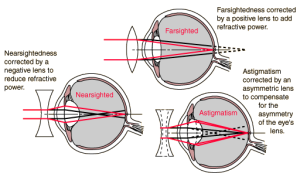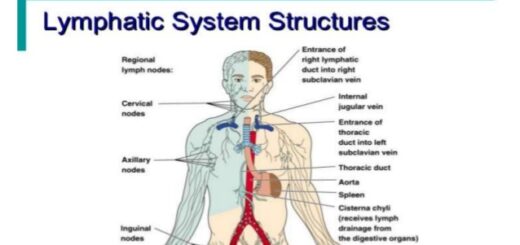Uses of lenses to treat the vision defects
The light rays reflect from the body to fall on the eye, Light rays refract when passing through the cornea then the lens (the convex lens), The refracted rays are collected on the retina forming a small, real inverted image.
The vision
The optic (sight) nerve transmits the image to the brain which re-corrects the image to become erect and in its natural size, The eyeball diameter is the distance between the lens optical center and the retina. The image must be formed on the retina to see clearly, The normal person can see clearly the near objects (at a distance, not less than 25 cm) and the far objects (at a distance up to 6 m).
Uses of lenses to treat the vision defects
The vision defects occur because the eye cornea is not always convex or the eye is not always spherical, The most important vision defects are short-sightedness and long-sightedness.
Short-sightedness
The short-sightedness is a vision defect through which the near objects can be seen clearly but the far objects seem distorted, The images of the far objects do not fall on the retina of the eye but in front of it.
Short-sightedness reasons
The short-sightedness is due to the increase in the eyeball diameter that causes the retina to be far from the eye lens, and the increase in convexity of the eye lens surface that results in a smaller focal length of the eye lens, the parallel rays coming from the far object are collected at a point in front of the retina and disperses after that forming an unclear image.
Correcting short-sightedness
The short-sightedness is corrected by using a concave lens which diverges the rays coming from the far object, so, the image of the object is formed on the retina, Therefore, a short-sighted person needs medical eyeglasses with concave lenses.
Long-sightedness
The long-sightedness is a vision defect through which the far objects only can be seen clearly but the close objects are not seen clearly, The images of close objects do not fall on the eye retina but behind it.
Reasons for long-sightedness
- The long-sightedness is due to the decrease of the eyeball diameter that causes the shortness of the radius of the eye sphere, thus the retina is close to the eye lens.
- The long-sightedness is due to the decrease of convexity of the eye surface that results in more focal length, so the rays coming from the near objects are collected in a point behind the eye retina.
Correcting long-sightedness
The long-sightedness is corrected by using a convex lens which collects the rays coming from the near objects, so, the image of the objects is formed on the retina, Therefore, a Long-sighted person needs medical eyeglasses with convex lenses.
Contact lenses
The contact lenses are used instead of the glasses to treat the vision defects, It is very thin lens that made of plastic, and they can stick to the eye cornea by the eye fluid.
Cataract disease
A cataract is one of the most dangerous diseases that infect the eye, It is due to the old age, illness, the side effects of drugs, and the genetic readiness.
The result of cataract is the difficulty of vision as a result of the darkness of the eye lens, The treatment of cataract is done through surgery to exchange the eye lens with a plastic lens transplanted permanently in the eye, So, the person can see again and clearly.
Lenses use, types, Convex lens, Concave lens, Vision defects, Contact lenses & Cataract
Types and uses of lenses in our life & special concepts related to the lenses
Properties of the formed images by convex lens and concave lens
Uses of the concave mirror and the convex mirror in our daily life














